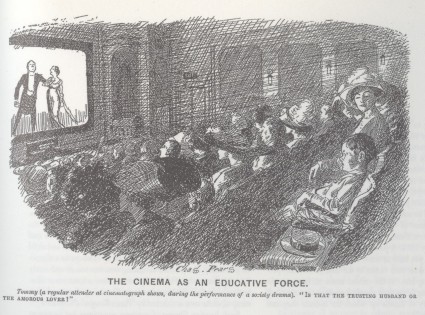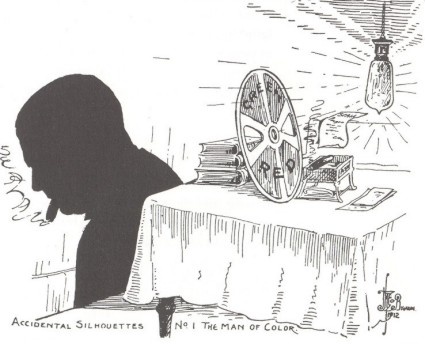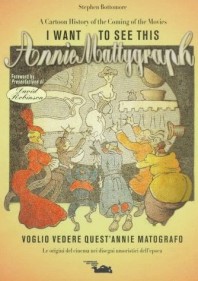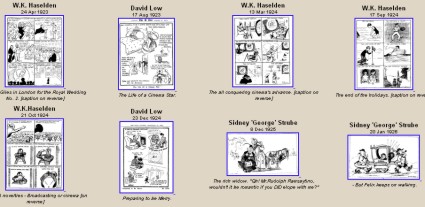‘The Cinema as an Educative Force. Tommy (a regular attender at cinematograph shows, during the performance of a society drama). “Is that the trusting husband or the amorous lover?”‘ Charles Pears cartoon in Punch, 7 August 1912, from I Want to See This Annie Mattygraph
One of the most interesting ways to examine contemporary perceptions of the silent cinema is through cartoons – newspaper cartoons, that is, rather than animated cartoons. Cartoons in the popular newspapers, comics and magazines of the day provide a marvellous measure of how the new phenomenon of cinema was commonly understood, since cartoons had to tap into a general feeling about the subject. Everyone had to be in on the joke for it to work. And more than simply recording popular sensibility, cartoons of the era pick up on changes in such aspects as technology and film-going habits, providing a valuable documentary record as well as a social history one.
‘Accidental Silhouettes no. 1: The Man of Color’, a cartoon of Charles Urban by Theodore Brown, from The Bioscope 22 February 1912
The film trade papers of the day are another source of cartoons and caricatures, not always so polished or so funny, but often picking up on minutiae of film business concerns which are of value to the specialists, or simply providing the only portraits we have of some of the film personalities (i.e. those behind the camera) that we have. Theodore Brown, editor of the British journal The Kinematograph and Lantern Weekly, unusually was also an occasional cartoonist (and a filmmaker, and an inventor), and provided the above cartoon of film producer Charles Urban, shown silhouetted via a Kinemacolor filter, which regulars will recognise provides my avatar in the comments to posts on this blog.
Cartoons on silent cinema are scattered all over the place, and tracking them down can be a laborious business – more often than not the research stumbles across them by chance, or else works their way through the well-thumbed pages of Punch, which never fails to come up with the goods of some sort. There is, however, one book – and a very good book – on the subject, Stephen Bottomore’s I Want to See This Annie Mattygraph: A Cartoon History of the Coming of the Movies (1995). It must be said that the mixture of ungainly title and bi-lingual text (English/Italian) has not helped the book’s acceptance outside the hardy band of early film buffs. (The phrase that gives the book its title comes from a cartoon where a man asks at a box office if he can see what he assumes is an actress but of course the Animatograph projector – how they laughed in 1897). But within lies a rich selection of contemporary cartoons from across Europe and America, arranged around such themes as ‘Going to the Pictures’, ‘Opposition and Rgulation’ and ‘Film Genres’, providing a history of the cinema to 1915 through the pictures that made people at the time laugh about it. It is scholarly, observant and great to look at. I particularly value it for the cartoons of cinema-going, where you find evidence of exhibition practice and audience habits that really aren’t recorded elsewhere. Its opening essay also provides a valuable history of the cartoon over and above its relationship to film history.
But what can you find online? Not a lot, unfortunately, but one worthwhile source to direct you to is the British Cartoon Archive. This is based at the University of Kent at Canterbury, and is effectively the national collection of cartoons. Navigation on the site is a little unclear, but persevere and you’ll eventually find its database, which provides access to 120,000 cartoons, each illustrated with thumbnail image (click on the image for a larger view) and accompanied by exemplary cataloguing information, including an exhaustive array of thesaurus terms, the names of all real people featured in the cartoon, and transcriptions of the text.
Sample database search result with cartoons by W.K. Haselden, Sidney ‘George’ Strube and David Low
The Archive is rightly particular about protecting copyright images, so no reproductions here bar the web page picture grab above. But type in terms like ‘film’, ‘cinema’ etc and you’ll find such telling cartoons as W.K. Haselden’s ‘The all-conquering cinema’s advance’ (1924), where cinema screens crop up everywhere you look (even at Stonehenge), or David Low’s ‘Continuous show now on’ (1926) which comments on the beleaguered state of the mediocre British film industry, unable to compete against the block-booking Americans, while the overpowering attractions of an American vamp obscure those of the ‘pure but dull British film heroine’.
There are only so many cartoons there on the silent era, but more than enough to pick up on the social perceptions of the time. Look out too for David Low’s ‘Topical Budget’, a cartoon news commentary series which took its name from a popular newsreel of the silent era. There’s a lot more to explore on the British Cartoon Archive site, in particular a collection of biographies of the cartoonists.
There are other, far smaller sites out there marketing mostly Punch cartoons, but nothing that I can see that provides the opportunity to look at early cinema subjects. The various newspapers that have been digitised tend to be of the broadsheet variety, which did not stoop to such things at this time. The British Library provides a useful overview of comics from the era, such as Ally Sloper’s Half-Holiday and Comic Cuts, as well as titles like Film Fun, which began in 1920 and was entirely given over to comic strips featuring popular film stars. Other sites and databases offer just an image or two, provide descriptive lists of what they have but no images, or else a subscription is required. Or they don’t cover early cinema, of course. For a good listing of sites worldwide, go to the Intute: Art and Humanities site (an excellent UK academic service describing online scholarly resources) and type in ‘cartoons’.
Finally, it’s worth noting that a number of cartoonists of the era went on to become filmmakers. Among the best-known are Emile Cohl, Winsor McCay (‘Little Nemo’) and Harry Furniss. Cartoonists were filmed by the early filmmakers, often doing ‘lightning sketches’ (speedy drawings over a preparatory sketch), such as Tom Merry, J. Stuart Blackton and several British artists who contributed political sketches to proto-cartoon films during the First World War. The Library of Congress’ American Memory site includes Origins of American Animation, which demonstrates the interrelationship between paper and screen cartoons 1900-1921.
If anyone knows of other online sources for newspaper and comic journal cartoons which cover our period, do say.




Thanks, Luke for those nice comments about my book, and also for the critical ones, with which I agree. In retrospect I’d perhaps have titled it simply, ‘A Cartoon History of the Coming of the Movies’, because that was the aim of the book. I’d hoped that it would be seen as a general introduction to the early years of the movies, and that because of the witty images by cartoonists it would be read by non-specialist readers. But, as Mr Bioscope rightly says, it does feel a bit academic with its mysterious title and bilingual text, though the publishers did a beautiful job of editing and reproduction. At one point I thought of bringing out a new, slimmer and cheaper edition: English only, with the simpler title, and with new cartoons from the pre-1914 years which have come to light since my book was published (e.g. Luke shows us one, above, by Theodore Brown – an important cinema pioneer and cartoonist whom I totally neglected in the book). Maybe one day this new edition will materialise.
Another great informative post, thank you !
Any suggestion as to a couple of handy sources on American cartoons and American films, for the 1920s ?
Pingback: Film cartoons - Olive Butter 1922 « flycz
Hello first to Stephen. Those weren’t meant to be critical comments. I may just be guessing that some would-be readers are put off by bi-lingual texts, but it’s important to remember the wise decision of the Giornate del Cinema Muto in publishing the book, and of course making it accessible to a wider range of readers. I just think it’s a great book and more than merits wider recognition. I’m glad to hear you are still collecting more cartoons. It ought to make a rather fine exhibition one day.
And hello to flyczba. I don’t know of any comparable American source (does anyone?). The British Cartoon Archive is quite unusual in the sheer number of images it has been able to publish online. There are others out there, like America’s National Cartoon Museum or Ohio State University’s Cartoon Research Library, but such resources generally offer database listings only, or publish just a handful of images, owing to rights restrictions. There are a number of online exhibition of historic cartoons, of course, but generally on political themes – nothing that I know of on cinema, silent or otherwise. The best place to start looking for yourself is the British Cartoon Archive’s impressive links page.